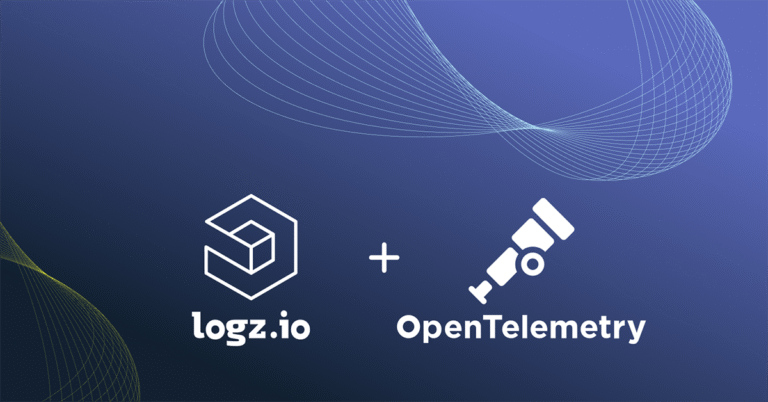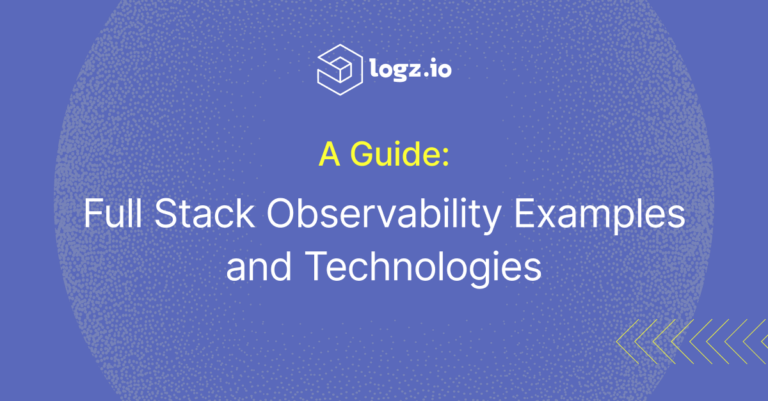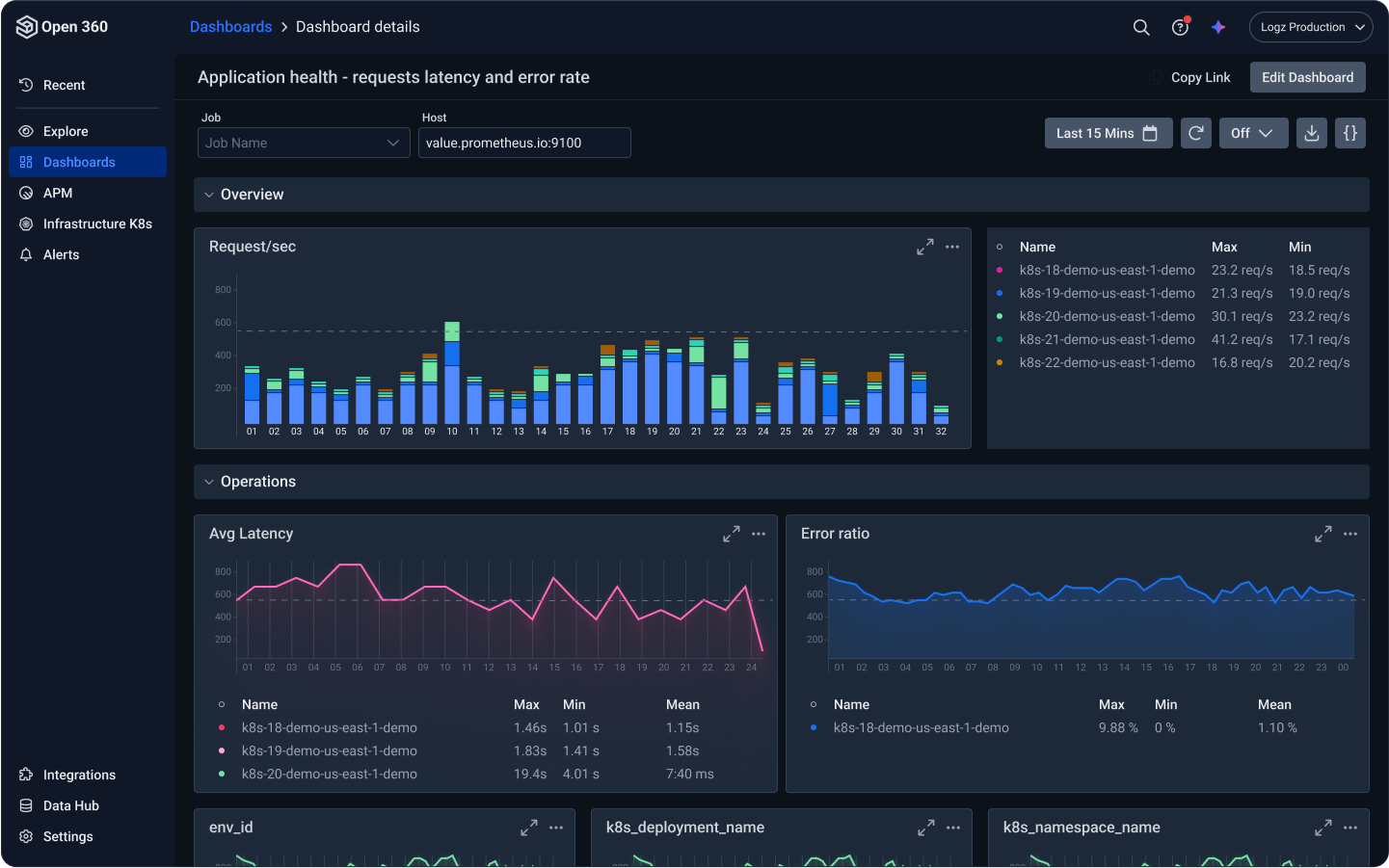
OpenTelemetry Observability: An In-Depth Look at Features and Best Practices
September 18, 2025

Key Takeaways
- OTel is the open-source standard for collecting, processing, and exporting telemetry data (logs, metrics, traces).
- OTel handles data collection, but not analysis. Look for backend tools that natively support OTel, optimize pipelines, and fit your observability goals.
- Out-of-the-box, OTel can create noisy data, add setup complexity, and miss advanced features. Solve this by using collectors and a backend that enriches OTel data with APM and dashboards.
- OTel evolves quickly as a CNCF project. Choose vendors that actively contribute to the ecosystem.
Why OpenTelemetry Matters for Modern Observability
OpenTelemetry (OTel) is a unified framework of APIs, SDKs and tools, for collecting, processing, and exporting telemetry data (logs, metrics, and traces) across applications and infrastructure.
OTel is especially required in today’s cloud-native world, where applications run on microservices, Kubernetes, and distributed systems. While traditional observability tools struggle with fragmented or proprietary data formats, OpenTelemetry gives microservices environments end-to-end visibility, while ensuring context flows seamlessly across distributed services. It also reduces noise, scales with Kubernetes, and enables vendor flexibility so teams can adopt best-of-breed observability tools without re-instrumenting.
In the past few years, OTel has quickly become the open-source standard for telemetry data instrumentation.
Key Features of OpenTelemetry for Enterprise Observability
- Unified Telemetry Collection – OpenTelemetry provides a standardized framework for traces, metrics, and logs collections. This replaces proprietary SDKs or siloed tools, ensuring consistency and lowering operational overhead.
- Vendor-Neutral and Interoperable – OpenTelemetry decouples data collection from data analysis, so telemetry data can be forwarded to any backend. For example, open-source tools or platforms such as Logz.io. This flexibility helps avoid vendor lock-in.
- Broad Language and Framework Support – OpenTelemetry offers SDKs and instrumentation libraries for popular programming languages: Java, JavaScript/Node.js, Python, Go, .NET, PHP, Ruby, C++, Erlang/Elixir, Swift, and Rust. This allows any user to benefit from OpenTelemetry.
- Automatic and Manual Instrumentation – OTel provides auto-instrumentation libraries and agents, as well as OTel APIs. Developers can choose when to automate and when to custom-define spans, attributes, or events.
- Cloud-Native Integrations – OpenTelemetry integrates with Kubernetes, containerized workloads, and service meshes. This is required for cloud-native observability with OpenTelemetry.
- Rich Data Pipeline & Collector – The OpenTelemetry Collector enables efficient telemetry pipelines by batching, filtering, sampling, and transforming data across formats before sending it to downstream systems.
- Community-Driven, CNCF Project – OpenTelemetry is continuously evolving with strong community contributions. This means that enterprise observability enterprises can rely on long-term support, active development, and widespread adoption across the industry.
Choosing the Right OpenTelemetry Observability Tools
OpenTelemetry enables instrumenting logs, metrics, and traces. But it doesn’t solve for efficiency, noise reduction, or long-term value like insights, storage, and advanced APM features. A tool built on top of OTel adds these capabilities, making telemetry easier to deploy, manage, and actually use for troubleshooting and optimization.
Here’s what to look for:
- Start with Your Observability Goals – Before choosing a tool, you need clarity on what you want from observability: faster incident resolution, proactive anomaly detection, compliance reporting, reducing tool sprawl, etc. Choose a backend tool that can answer your goals.
- Evaluate Compatibility with OpenTelemetry – Most modern observability platforms claim they support OpenTelemetry, but the “how” varies. Some natively ingest OTel data, while others require extra configuration or use proprietary extensions. Prioritize platforms with first-class OpenTelemetry integrations, support for the OTel collector or tools that have a collector built on the OTel foundation and standards, like Logz.io, to minimize friction and noise and ensure smooth scaling.
- Ensure Efficient Data Collection and Processing – To ensure only the most valuable telemetry is processed, it’s important to optimize data before it’s exported. Look for tools that provide an OTel agent or mechanism that collect, normalize, and route data, allowing filtering, sampling, and enrichment before data leaves the environment.
- Check Deployment & Configuration Flexibility – OSS integrations sometimes mean deployment friction. Look for tools that offer pre-packaged configurations (e.g., Helm charts, operators) to simplify setup, custom pipelines and modular deployments.
- Future-Proof with Ecosystem Support – Since OpenTelemetry is constantly being developed, select vendors and tools that are active contributors to OSS. This ensures the tool stays aligned with the latest OTel standards and features, avoids compatibility gaps, and benefits from future community-driven innovations. For example, Logz.io offers an OTel OSS repository that is an OTel fork, which the community can contribute to as well.
Common Challenges of OTel and How to Overcome Them
OTel is a popular and excellent OSS solution for telemetry data instrumentation. But it comes with its own set of challenges. Here’s how to address them:
- Noisy, inefficient data collection – Raw OTel collectors grab everything, creating unnecessary overhead and high costs.
The Solution: Use a tool with built-in optimizations to filter and enrich data, sending only what’s valuable and relevant for observability. - Limited out-of-the-box features – Open source OTel ensures data gets shipped, but advanced features like APM, insights, or tailored pipelines aren’t included.
The Solution: Look for a solution with custom pipelines, integrations, and platform capabilities that unlock richer insights beyond basic telemetry. - Complex setup & configuration – Deploying and maintaining collectors, operators, and auto-instrumentation often requires manual effort.
The Solution: Helm charts, operators, and auto-instrumentation tools can simplify deployment and reduce the need for code changes. - Vendor lock-in risks – Many observability tools create dependency traps by forcing proprietary formats or agents.
The Solution: Choose a fully OTel-compatible shipper that supports open standards, making migration and integration easier without lock-in. - Scalability inefficiencies – Standard OTel collectors don’t optimize for scale and can add unnecessary load on infrastructure.
The Solution: Find optimized agents and collectors scale efficiently, ensuring performance without overloading systems. - Data without context – Raw telemetry streams alone don’t provide the higher-level insights teams need.
The Solution: Look for a tool that adapts incoming OTel data to the platform, enabling advanced features like correlated dashboards, APM views, and long-term storage.
FAQs
Can OpenTelemetry be used in hybrid or multi-cloud environments?
OpenTelemetry is purpose-built for hybrid and multi-cloud observability. Since it’s an open standard for telemetry data collection, it can be deployed consistently across on-premises systems, private clouds, and multiple public cloud providers.
How does OpenTelemetry differ from proprietary observability solutions?
Proprietary observability solutions often bundle data collection with backend analysis, using custom agents or SDKs that lock customers into their ecosystem. OpenTelemetry decouples data collection from analysis, standardizing how telemetry is generated and allowing it to be exported to any compatible backend.
What are the main benefits of using OpenTelemetry for distributed tracing?
OpenTelemetry simplifies tracing by providing a consistent API and SDKs across many languages, making it easy to propagate context and follow requests end-to-end. Enterprises can then send trace data to tools like Jaeger or Logz.io for RCA.





